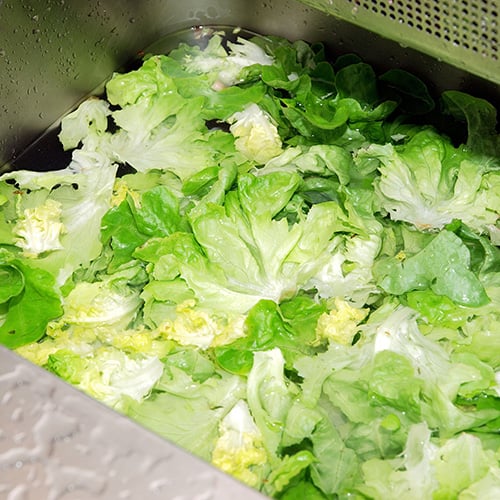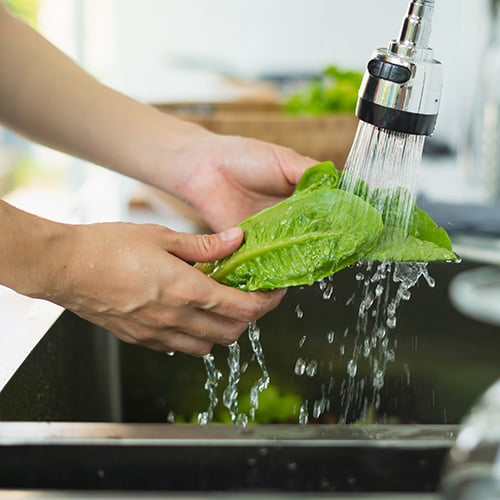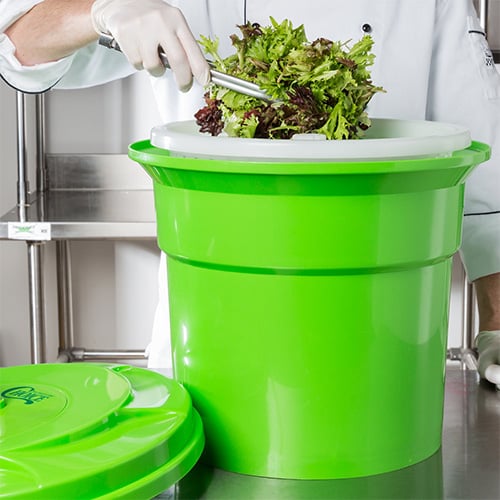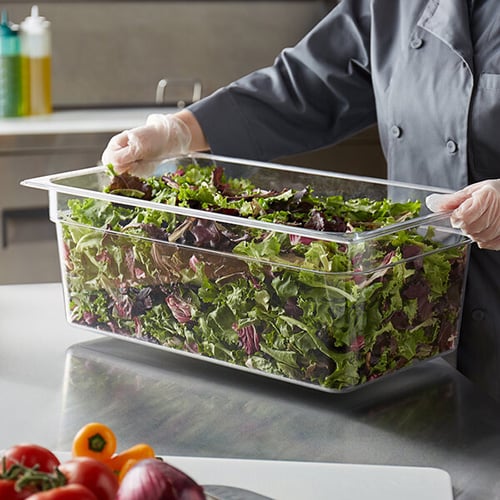How To Clean A Head Of Lettuce
How to Wash Lettuce
For busy restaurants, washing fresh produce is a time-consuming operation. Heads of lettuce like romaine are notoriously difficult to wash because of the creases between the leaves where dirt and grit can hide. We'll go over the best way to wash your salad greens and how to give them the proper care so they stay fresh and crisp.
Already know how to wash romaine lettuce? Click below to find salad spinners that dry several heads of lettuce at a time.
Shop All Salad Spinners
Use these links to learn more about prepping your romaine lettuce:
- How To Wash Lettuce
- How To Dry Lettuce
- Lettuce Storage
- Lettuce Washing FAQs
How to Clean Greens
Your salad greens will actually look and taste better when they're washed and dried the right way. Customers that order salad from your menu expect to see clean, crisp lettuce that's free from grit and perfectly coated in dressing. If your lettuce is wilted or damp, the vinaigrette won't cling to the greens and the dish loses its appeal. Try these two methods for washing romaine lettuce and other types of greens to make sure they look and taste great.
1. Cold Bath Method

The cold bath soaking method is the best way to wash large quantities of lettuce like romaine, green leaf, or butterhead. When you're working with cases of lettuce that need to be prepped quickly, soaking allows you to make the most of your time. To use this method, you need a large sink designated for washing produce. Do not use a hand sink, mop sink, or warewashing sink.
- Wash your hands with soap for 20 seconds before handling produce
- Use a sink designated for washing produce (never use a handwashing sink or a sink used for thawing meats)
- Wash and sanitize the basin of the sink before prepping
- Fill the sink basin with cool water
- Consult the kitchen prep sheet and pull the right quantity of lettuce out of storage
- Inspect the greens for visible signs of contamination
- Remove any portions of the head that have been cut or damaged (bacteria can get inside lettuce leaves that have been damaged)
- Remove the outer leaves from the heads and throw them away
- Separate the leaves by hand or slice off the root of the lettuce head
- Place the leaves in the sink and swirl the water with your hand
- Soak the leaves for about 10 minutes, giving them a good swirl every few minutes
- The dirt and grit will sink to the bottom of the basin
- Remove the leaves and place directly into a salad spinner
- Drain and clean the sink basin
Can You Wash Whole Heads of Lettuce?
Yes, you can wash whole heads of romaine using the soaking method. Gently lift the leaves and spread them apart while they soak to loosen dirt and grit. This method doesn't work for iceberg lettuce because the leaves grow tightly together.
Should You Cut Up the Lettuce Before Washing?
We recommend washing and drying the lettuce before cutting up the entire head. If you cut up the lettuce while the head is still dirty, you end up spreading the grit around. Cutting the leaves also causes the lettuce to oxidize more quickly.
2. Running Water Method

The running water method is a great way to clean lettuce, but it's not practical for washing whole cases of produce. Use this method when you need to prep one head of lettuce or a few leaves.
- Wash your hands with soap for 20 seconds before handling produce
- Use a sink designated for washing produce (never use a handwashing sink or a sink used for thawing meats)
- Wash the basin of the sink before prepping
- Inspect the greens for visible signs of contamination
- Remove any portions of the head that have been cut or damaged. Bacteria can get inside lettuce leaves that have been damaged.
- Remove the outer leaves from the heads and throw them away
- Turn on the cool water and rinse each leaf by hand
- Scrub the leaf gently with your fingers, paying special attention to the creases
- Lay the freshly washed leaves on a clean flour sack towel to dry
How to Dry Salad Greens

Drying salad greens after washing helps to keep them crisp and prevents wilting in storage. The best way to dry large amounts of romaine or other greens is to use a commercial salad spinner.
What Is a Salad Spinner?
A salad spinner is a useful kitchen tool that applies centrifugal force (spinning action) to dry salad greens. It works by spinning an interior basket using manual or electric power. As the basket spins, any water droplets on the lettuce are forced into the outer container. Commercial salad spinners hold large quantities of salad greens and many have hoses that drain water from the container. Follow these steps to use a commercial salad spinner:
- Transfer freshly washed salad greens to the inner basket of the salad spinner
- Be careful not to overload the salad basket or the greens won't dry properly
- Close the lid and spin the handle to rotate the basket
- Keep spinning the basket until the lettuce is completely dry
- Empty or drain any water from the outer container
- Use lettuce immediately or place it in a food pan for storage
How to Store Fresh Greens

Your produce storage method is just as important as proper cleaning and drying. If you pack freshly washed greens into one container with no air flow, moisture will cause the leaves to wilt. You can reduce food waste and make sure your salads are picture-perfect by using these methods for storage:
- Food Pan with Drain Tray - Loosely fill a full-size plastic food pan with clean, dry romaine lettuce. A drain tray placed in the bottom of the pan will prevent any remaining water droplets from pooling around the produce. For added measure, place a couple clean paper towels in the pan to absorb any moisture left behind. Top the pan with a loose-fitting lid. Do not seal the pan completely. A little air flow will help prevent the lettuce from wilting.
- Rolled Towel - The rolled towel method works well for storing smaller quantities of lettuce leaves. Lay out the lettuce on a clean flour sack towel and roll it up into a tube shape with the leaves inside. Twist the open ends of the towel roll or secure them with clips. Store the roll in the walk-in and remove leaves as needed.
Lettuce Washing FAQs
We answer common questions about washing lettuce below:
Do I Need to Wash Lettuce?
Yes, it's important to wash all fresh produce, but especially leafy greens and lettuce. Harmful bacteria from the soil can contaminate fruits and vegetables and lead to a foodborne illness if consumed. There's a higher risk associated with produce that is eaten raw, like romaine lettuce and salad greens. The cooking process eliminates bacteria, so uncooked foods don't benefit from the high temperatures that kill pathogens. Make sure to carefully wash your salad greens to remove pesticides, dirt, and harmful bacteria.
How Does Romaine Lettuce Become Contaminated?
Leafy greens like romaine can become contaminated with bacteria through agricultural runoff, contaminated water supply, and close proximity to livestock or other animals. Any nearby feeding or grazing activity, whether wild or domestic, can lead to contamination.
Does Washing Lettuce Remove All Bacteria?
Washing lettuce removes most of the bacteria from the surface of leafy greens, but if the lettuce has been contaminated through the water supply, washing cannot remove 100% of the contamination. The best way to avoid purchasing contaminated greens for your restaurant is to work with produce suppliers that follow strict adherence to a food safety management program. In 2020, the FDA created an action plan to address the safety concerns related to contaminated leafy greens. Check out the Leafy Greens STEC Action Plan to learn how the FDA is taking steps to prevent future outbreaks.
Most commercial kitchens go through large quantities of romaine lettuce on a daily basis. You can make your lettuce prep more efficient and improve the quality of your leafy greens by using our guide.
How To Clean A Head Of Lettuce
Source: https://www.webstaurantstore.com/blog/3690/how-to-wash-lettuce.html
Posted by: mileyclus1971.blogspot.com

0 Response to "How To Clean A Head Of Lettuce"
Post a Comment